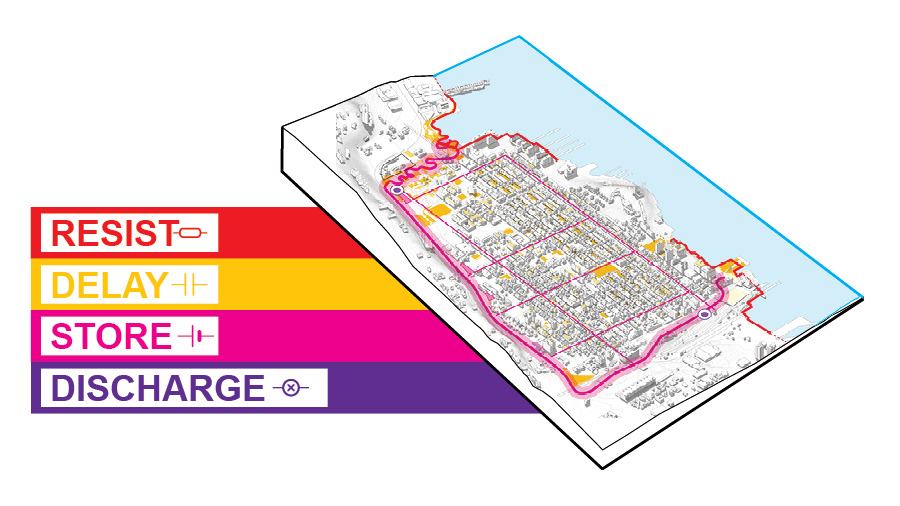The reality of global climate change became evident to millions in New York, New Jersey, and Connecticut when Hurricane Sandy devastated the tri-state area in 2012. Now we have Rebuild by Design, a set of more or less concrete proposals, commissioned by the Hurricane Sandy Rebuilding Task Force—one of Mayor Bloomberg’s legacies—and the U.S. Department of Housing and Urban Development. Ten interdisciplinary design teams have made proposals that would, if they were ever implemented, not only make the coastal areas more resistant to flood damage, but would also improve the quality of life in those places. I hate to say it—because some of these designs are breathtaking—but good luck with that.
The strategy in designing for this area is—as the team led by OMA put it most succinctly—to “resist, delay, store, discharge.” Low-lying areas need to be able to cope with rising sea levels, as well as more groundwater due to rain and higher river levels. They need to delay water as it comes in, giving both natural and human-made infrastructure a change to absorb these new volumes of wet stuff. They must then figure out how to get rid of that water.
The answer is a combination of wetlands; reinforcements of coastal and riverine areas with artificial or new dunes; levees and storm barriers; more flood-resistant buildings; and storage basins, canals, and other discharge elements. That sounds a lot like the Netherlands to me, and a majority of the teams include Dutch designers and consultants. After all, the Dutch have been living on artificial land below sea level for centuries. It’s not rocket science. It’s the science of water management, and the strategies are well-known.
Who is going to pay for all this? We the taxpayers. However, we—or rather our elected representatives—have a bad record of improving our infrastructure, as I have noted before. Rebuild by Design’s answer seems to be a combination of citizen participation in the planning process, and the making of attractive public space that contains or exhibits the flood-control measures.
The sexiest proposal, for instance, is that of the team led by Bjarke Ingels Group, which envisions new parkland circling most of Manhattan, a “reverse aquarium” or awareness center at Battery Park, and floodgates attached to the bottom of the Manhattan Bridge decorated by artists. I would say Bjarke Ingels, BIG’s principal, knows how to make good design visible better than any architect working today.
The most daring proposal is that of Dutch landscape architecture firm West 8 and New York-based firm WXY Architecture + Urban Design. The team’s idea is to erect a line of barrier dunes far in front of the coast, all the way from the tip of Long Island to the south of New Jersey. It is a beautiful concept, though West 8 lead designer Adriaan Geuze has been trying this for years on the Netherlands, and even there the vision is considered too radical and expensive.
What seems more plausible is the more modest parks and breakwaters that team SCAPE/Landscape Architecture proposes for Staten Island, and the rebuilding of the Meadowlands as a marsh with a densely developed edge. But even these designs are ambitious: The more small-scale and development-oriented improvements PennDesign and Olin envision in Bridgeport, N.J. and the designs of Cooper, Robertson, & Partners for Brooklyn and the Bronx at least seem doable—under a truly progressive administration.
Rebuild by Design provides visions of what we could and should be heading. We know we have to do something. Through this effort we know how we can do it. Now we just have to do it—or move to Ohio.
Aaron Betsky is a regularly featured columnist whose stories appear on this website each week. His views and conclusions are not necessarily those of ARCHITECT magazine nor of the American Institute of Architects.
